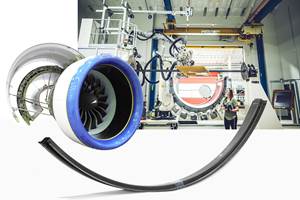MIT and NASA engineers design lightweight polymer airplane wing
The wing, comprising a lattice of injection-molded, configurable polymer subassemblies, is designed to change shape during flight.
A team of engineers from NASA’s Ames Research Center (Moutain View, Calif., U.S.) and the Massachussetts Institute of Technology (MIT, Cambridge, Mass., U.S.) have built and tested an airplane wing assembled from a lattice comprising hundreds of tiny identical polymer pieces. The wing reportedly can change shape to control the plane’s flight.
The wing design was tested in a NASA wind tunnel and is described in a paper in the journal Smart Materials and Structures, co-authored by research engineer Nicholas Cramer at NASA Ames in California; NASA Ames engineer and MIT alumnus Kenneth Cheung; MIT graduate student Benjamin Jenett and eight others.
Instead of requiring separate movable surfaces such as ailerons to control the roll and pitch of the plane, as conventional wings do, the new assembly system makes it possible to deform the whole wing, or parts of it, by incorporating a mix of stiff and flexible components in its structure. The tiny subassemblies, which are bolted together to form an open, lightweight lattice framework, are then covered with a thin layer of similar polymer material as the framework.
The result is a wing that is lighter, and thus more energy-efficient, than those with conventional designs, whether made from metal or composites, the researchers say. Because the structure, comprising thousands of tiny triangles of matchstick-like struts, is composed mostly of empty space, it forms a mechanical “metamaterial” that combines the structural stiffness of a rubber-like polymer and the extreme lightness and low density of an aerogel.
Jenett explains that there is a different set of optimal wing parameters for each phase of flight, to provide a better approximation of the best configuration for each stage. The system is designed to automatically respond to changes in its aerodynamic loading conditions by shifting its shape in specific ways.
A meter-long demonstrator wing was created by Cheung and other team members a few years ago. The new version, about five times as long, is comparable in size to the wing of a real single-seater plane and is designed to be easily accomplished by autonomous assembly robots. The design and testing of the robotic assembly system is the subject of an upcoming paper, Jenett says.
The individual parts for the previous wing were cut using a waterjet system, and it took several minutes to make each part, Jenett says. The new system uses injection molding with polyethylene resin in a complex 3D mold, and produces each part — essentially a hollow cube made up of matchstick-size struts along each edge — in just 17 seconds, he says, which brings it much closer to scalable production levels.
“Now we have a manufacturing method,” he says. While there’s an upfront investment in tooling, once that’s done, “the parts are cheap,” he says. “We have boxes and boxes of them, all the same.”
The resulting lattice, he says, has a density of 5.6 kilograms per cubic meter. By way of comparison, rubber has a density of about 1,500 kilograms per cubic meter. “They have the same stiffness, but ours has less than roughly one-thousandth of the density,” Jenett says.
Because the overall configuration of the wing or other structure is built up from tiny subunits, the overall design of the wing structure could be changed from its traditional shape, Jenett says. Studies have shown that an integrated body and wing structure could be far more efficient for many applications, he says, and with this system those could be easily built, tested, modified and retested.
The same system could be used to make other structures as well, Jenett says, including the wing-like blades of wind turbines, where the ability to do on-site assembly could avoid the problems of transporting ever-longer blades. Similar assemblies are being developed to build space structures, and could eventually be used for bridges and other high-performance structures.
The team included researchers at Cornell University, the University of California at Berkeley, the University of California at Santa Cruz, NASA Langley Research Center, Kaunas University of Technology in Lithuania, and Qualified Technical Services Inc., in Moffett Field, Calif., U.S. The work was supported by NASA ARMD Convergent Aeronautics Solutions Program (MADCAT Project) and the MIT Center for Bits and Atoms.
Related Content
The potential for thermoplastic composite nacelles
Collins Aerospace draws on global team, decades of experience to demonstrate large, curved AFP and welded structures for the next generation of aircraft.
Read MoreAutomated robotic NDT enhances capabilities for composites
Kineco Kaman Composites India uses a bespoke Fill Accubot ultrasonic testing system to boost inspection efficiency and productivity.
Read MoreWelding is not bonding
Discussion of the issues in our understanding of thermoplastic composite welded structures and certification of the latest materials and welding technologies for future airframes.
Read MoreCombining multifunctional thermoplastic composites, additive manufacturing for next-gen airframe structures
The DOMMINIO project combines AFP with 3D printed gyroid cores, embedded SHM sensors and smart materials for induction-driven disassembly of parts at end of life.
Read MoreRead Next
Cutting 100 pounds, certification time for the X-59 nose cone
Swift Engineering used HyperX software to remove 100 pounds from 38-foot graphite/epoxy cored nose cone for X-59 supersonic aircraft.
Read MoreScaling up, optimizing the flax fiber composite camper
Greenlander’s Sherpa RV cab, which is largely constructed from flax fiber/bio-epoxy sandwich panels, nears commercial production readiness and next-generation scale-up.
Read MoreNext-gen fan blades: Hybrid twin RTM, printed sensors, laser shock disassembly
MORPHO project demonstrates blade with 20% faster RTM cure cycle, uses AI-based monitoring for improved maintenance/life cycle management and proves laser shock disassembly for recycling.
Read More.jpg;width=70;height=70;mode=crop)












